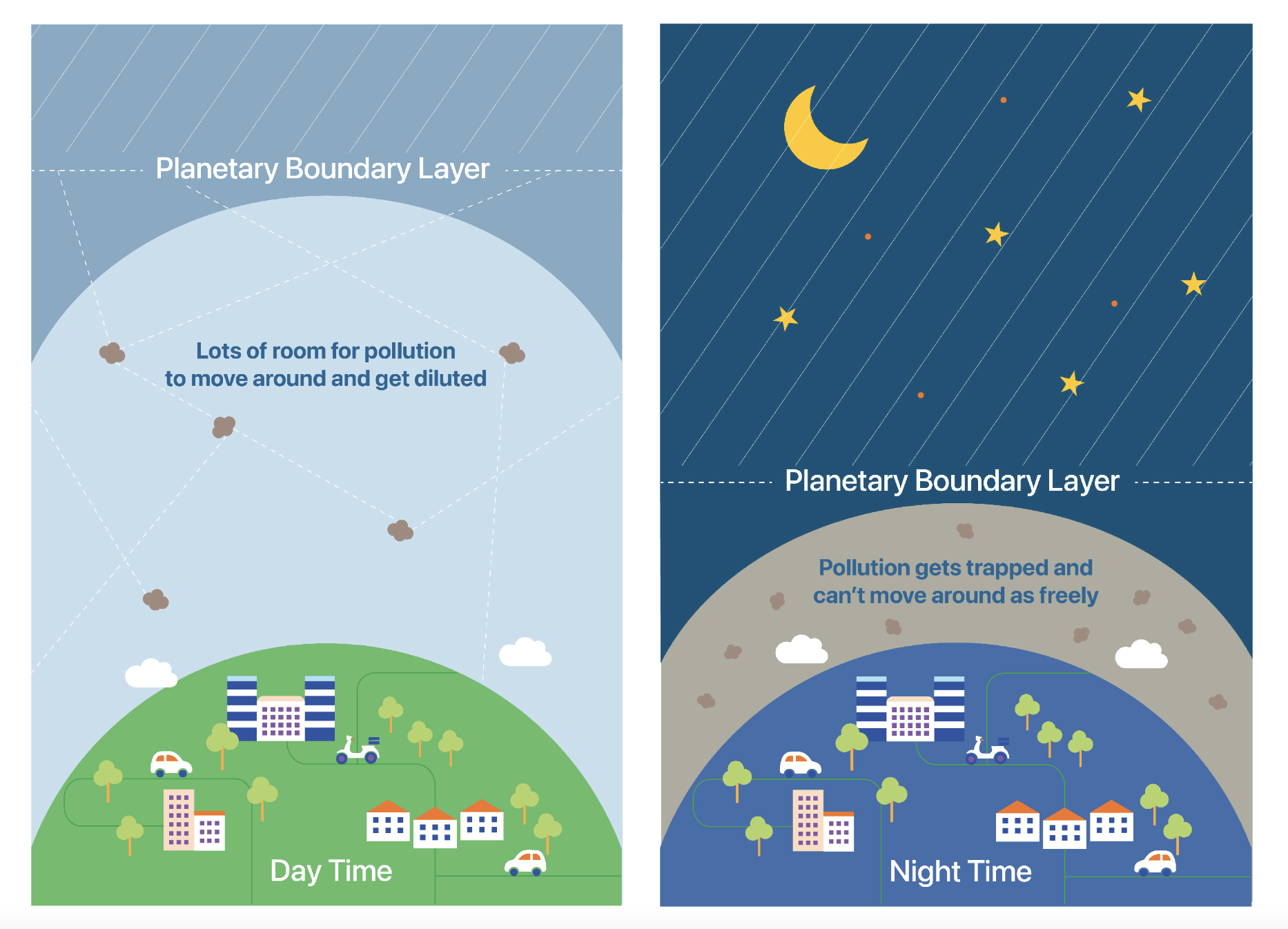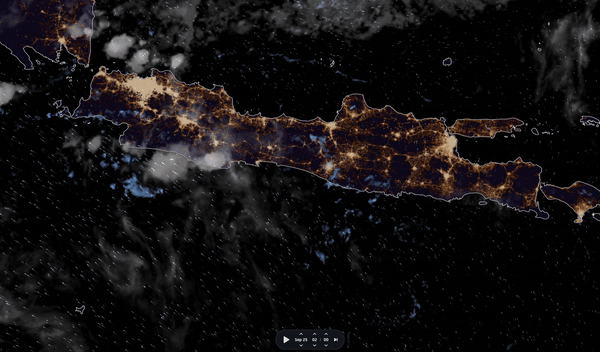How do wind patterns and geographical conditions make air quality different across Java?
There has been an interesting phenomenon in the last 2 weeks, where the air quality in some cities is monitored to be unhealthy from night to mornings, such as Greater Jakarta, Bandung, Semarang, and Surabaya.
As it should be, it is well-known that the air quality at night is worse than during the day. Some of you might also just know about this! This is because the Planetary Boundary Layer in the air makes it difficult for pollutants to disperse. Let’s take a look at this picture!
During the day, the Planetary Boundary Layer is large and there is more space for these pollution particles to move around, causing the concentrations to get diluted. This is why air pollution levels might be lower during the day when there are a lot of cars out during the rush hour. During the night, Planetary Boundary Layer becomes shallow and there is less space for these pollution particles to move around, causing them to get concentrated and making the air pollution levels higher in the middle of the night.
However, this phenomenon (night: bad air) does not apply to Yogyakarta, Malang, and Bali — cities in the southern part of the islands. These cities remain green in color from night to morning, indicating healthy air quality. What's going on?
Southern air quality > Northern air quality
Take a look at the map below!



If you notice, many of the cities with poor air quality are located in the northern part of Java. Yogyakarta and Malang, which are located in the southern part of Java, show the opposite air quality. What's unusual is that this happens at night and in the morning. Why does this happen?
Wind direction and speed affect air quality in locations
One of the biggest factors affecting air quality in a place is wind direction and speed. Let's take a look at the wind direction below!
The wind is seen moving from the south, carrying away the accumulated pollutants and clearing the skies in the southern cities. The stronger the wind, the more air pollution is dispersed.
Mountains block the wind from the south
These winds don't reach cities in the north because they are blocked by the mountains between the south and north of Java Island. These are the mountains that block the wind from the south:
🗻 The south side of Jabodetabek is blocked by Mount Salak, Mount Pangrango, and the Bogor plateau
🗻 The south side of Bandung is blocked by Mount Cikuray and others
🗻 The south side of Semarang is blocked by Mount Sindoro and Mount Sumbing
🗻 The south side of Surabaya is blocked by Mount Bromo and others
Therefore, cities in the north are not exposed to strong winds from the south, causing air pollution to gather and remain high in concentration.
Nafas tries to compare air quality data on September 24, 2022, in Yogyakarta City (south) and Semarang City (north). Check out the graph below!

The graph shows that Yogyakarta, which is close to the south coast, has better air quality than Semarang during the night and early morning when conditions are windy. The mountains are what hold this wind to fly to the north, causing air pollution to not be dispersed.
Wind has a big influence on air quality
Wind can wash away pollution, especially PM2.5 particles when the wind blows. If the wind is calm, pollutants cannot disperse, building up the concentration of these pollutants. On the other hand, higher wind speeds normally translate to a greater dispersion of air pollutants, resulting in lower air pollution concentrations in windy areas.
Some of you may know this ‘green’ that occurred in southern cities of Java - triggered by a bigger scale of wind. One of them is known as the Monsoon wind, a special wind pattern in Indonesia. During the dry season, it’s the East Monsoon wind, which comes all the way from Australia to Asia. During the rainy season, it’s West Monsoon wind, which does the opposite.
In this case, in September, we are in the transitional (pancaroba) season, where the wind can move dynamically. The Nafas Team observed a strong wind blowing from Australia toward Java. This strong wind blows when the atmosphere is stable (at night), causing PM2.5 which usually accumulates to be dispersed and decrease in concentration in the air. As a result, we can see green at night in the south of Java, indicating good air quality.
Keep improving the quality of the air we breathe
We know that air quality is often unpredictable, depending on the many factors that influence it. Hence, it is best to prevent exposure when the air quality is not good. Here are some bullet points to keep in mind:
- Always monitor air quality before your activities with the Nafas app. Nafas gives you recommendations on preventive measures you can take based on the air quality in your location.
- Reduce outdoor activities when the air quality is unhealthy. If you must do activities outside, always protect yourself by wearing an N95 mask.
- Consider using a HEPA-filtered air purifier to remove airborne particles in your home and improve your indoor air quality.
👨👧👦 Start a healthy living habit by improving air quality and a clean environment with Nafas!